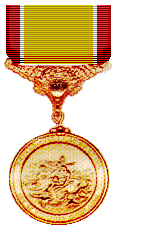
Gold
Lifesaving Medal

The original Lifesaving medals, created on June 20, 1874, were not
intended to be worn. The original Gold Medal had the inscription "Life
Saving Medal of the First Class" at the top. An Act of Congress dated June
18, 1878 made changes to the original design, making the medal smaller and
omitting the inscription. The modification to the original Medal was
authorized by an Act of Congress on May 4, 1882 and was awarded to any person
who rescues, or endeavors to rescue, any other person from drowning,
shipwreck, or other peril of the water. The rescue must take place in waters
within the United States or subject to U.S. jurisdiction, or one of the
parties must be a citizen of the United States, and the rescue must have been
made at the risk of the rescuer's own life, with evidence of extreme and
heroic daring. The modified medal was worn on a ruby red ribbon and was issued
from 1882-1949. The changes which resulted in the current Gold Lifesaving
Medal started with a memorandum from Commandant of the Coast Guard, Admiral
J.F. Farley, dated March 13, 1946. Changes included reducing the size of the
medal to "...present a more harmonious appearance when they are worn on the
uniform with other medals...", and changing the color of the ribbon to the
current gold, red, and white. The revised medal was struck in pure gold. The
inscription on the lower obverse was changed to "Act of Congress August 4,
1949."